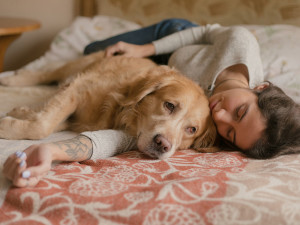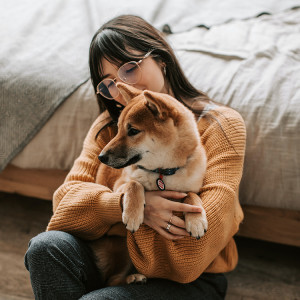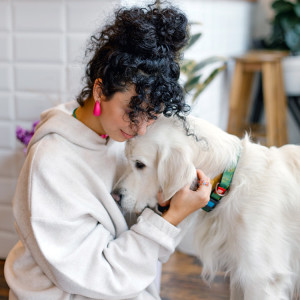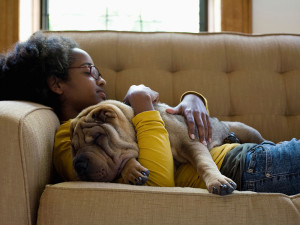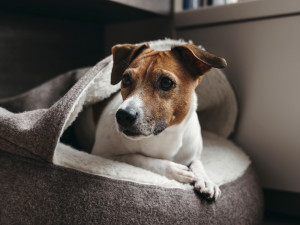What to Do When Your Dog Is Even More Anxious Than You Are
Did you get a dog for emotional support and now they are the one who needs it?
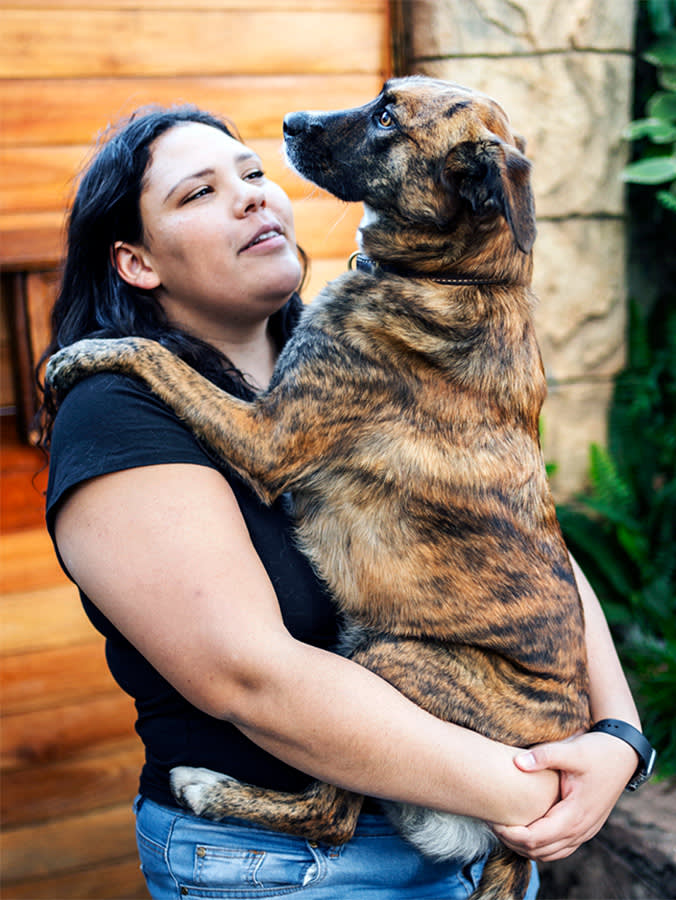
share article
My dog Ava can be a ball of nervous energy. Just like her mother. It’s a real “who rescued who” situation when it comes to soothing our respective anxieties. But, if it’s any consolation to fellow fretters, we are far from alone.
Nearly one in five U.S. householdsopens in a new tab adopted a dog or cat during the pandemic, and understandably so. Pets provide companionship, a way to ease stressopens in a new tab, a reason to put on pants and go outside. Research consistently shows that pets can improve our mental healthopens in a new tab, and, with a 25 percent global increase in depression and anxietyopens in a new tab during the first year of the pandemic, we’re still reeling from the impact COVID-19 has had on our collective mental health. Of course, as anyone with a dog will tell you, adopting a pet isn’t an emotional cure-all.
Take, for example, all those people on TikTok whose pet’s anxiety is an equal match for their ownopens in a new tab. This can run the gamut from pets experiencing a new-found degree of separation anxietyopens in a new tab as owners return to the office to pets who are on the sameopens in a new tab anti-anxiety medicationopens in a new tab as their owners. I’m convinced Ava has been conducting rigorous studies on how sad her ears must look in order for me to never leave her home alone. The results have been inconclusive as she continues to find even subtler ways to seem sad.
So, what’s a person to do when their emotional support dog needs emotional support of her own?
Is every dog an emotional support dog?
First, we need to differentiate between getting a dog for emotional support and a certified emotional support animal (ESA). Any pet can provide comfort, alleviate loneliness, and be cute in a way you are sure is medically beneficial. However, registering your dog as an ESAopens in a new tab does require you, as the owner, to have a consultation with and a letter from a certified mental health professional. On the other hand, your potential ESA has fewer criteria to meet than a registered service animal or psychiatric service dog. ESAs don’t require the training to perform specific tasks for people with disabilities like guiding an owner with sight loss or reminding an owner to take their medication.
Because there is no legal requirement for ESA training, navigating your pet’s individual behavior is crucial to actually experiencing emotional support. If your dog is experiencing high levels of anxiety, “they may not be able to serve their emotional support function at the current time until their anxiety is treated,” explains Dr. Valli Parthasarathy, PhD, DVM, DACVB.
If this is the case, Dr. Parthasarathy, who is also the co-owner of and Veterinary Behavior Specialist at Synergy Veterinary Behavioropens in a new tab in Portland, Oregon, recommends consulting with your dog’s vet and seeking behavior training so they can meet your required needs as a certified ESA.
If you aren’t looking for ESA certification but are hoping your anxious dog provides some comfort and support, rest assured there are ways you can ease their anxieties and, in turn, your own.
What does anxiety look like in dogs?
Dogs can “absolutely” experience anxiety, says Brett Currie, a canine public training and behavior manager at Wayside Waifs in Kansas City. In addition to more commonly-known separation anxiety, dogs can feel anxiousopens in a new tab when they’re afraid, in high-stress situations, and as they age. Unfortunately, we can’t just ask our pets how they’re feeling. (And even if we could, that might still lead to a completely different set of emotional issuesopens in a new tab.)
Dr. Parthasarathy reiterates that every dog is different, which means anxiety can look different from pet to pet. Common signs of anxiety to look out for include excessive panting, pacing, tense body posture, and piloerection (hair standing up along your pet’s back or shoulders).
She notes that some signs of anxiety are less obvious, like widened eyes, dilated pupils, and a lowered tail. But, just as it does among people, Dr. Parthasarathy says “the specific combination of signs will differ between [dogs] and may change depending on the situation.”
While other dogs may be more confrontational, Ava is a hider. But she also hides when she pees in the house and finds a dead bug she wants to study (i.e., roll in). You know your pet best and, with time and attention, can learn to tell the difference between a nervous wag and an excited one.
What do I do when I can tell my dog is anxious?
We know our dogs don’t live to satisfy our every whim, though sometimes it seems they think we live to serve theirs. (They’re right.) Constant pressure to perform can make anyone anxious, dogs included. Still, it’d be nice if our dogs would, you know, chill out every once in a while.
If you notice your dog seems more anxious than usual, “it's always a good idea to start with a visit to your vet to be sure there's nothing physically wrong that's causing stress or anxiety,” Currie recommends. “As long as their health checks out, it's important to try to identify what is causing their stress and anxiety and give them a break from it.”
Even my attention-seeking Ava needs a break from being pet every once in a while. It’s rare, but it happens. If it’s possible, removing either the source of stress or your pet from the situation is the best first option, both experts say. Unfortunately, this may mean you need to give your pet some space even though your parental instinct makes you want to carry them around in a BabyBjörnopens in a new tab.
If it isn’t possible to remove the source of stress (e.g., thunderstorms, fireworks, general existential dread), Currie suggests creating a quiet, comfortable space for your dog and providing enrichment toysopens in a new tab like frozen Kongs or LickiMats as helpful distractions. Dr. Parthasarathy adds that owners should also monitor how their dog’s behavior changes around other people and animals. “The more that people can learn to recognize anxiety, the sooner dogs can get help and often the better the outcomes are for treatment,” she says. For pets that experience anxiety frequently and more severely, Currie says to talk with your vet and a certified trainer about anti-anxiety medications or individualized coping skills for behavior modification.
OK, but what if my anxiety is exacerbated by my dogs?
Bummer news: Studies suggest that nervous pet owners tend to have nervous petsopens in a new tab. Better news: Feeling anxious when your dog is experiencing anxiety is totally understandable, says Dr. Parthasarathy, adding that “the best thing to do is to try to stay calm.” That is often easier said than done, so Currie suggests finding relaxing activities you and your dog can do together. “Sometimes reading out loud to a pet, going for a walk in a quiet area, or even playing a game of fetch in the yard can help ease your pet’s anxiety, as well as your own.”
Above all, both Currie and Dr. Parthasarathy emphasize that it’s OK to ask for help. “It’s always okay to seek professional help if you or your pet are struggling,” Currie says. “There’s no shame in seeking help to make you and your pet more comfortable.”

Mia Mercado
Mia Mercado is a writer whose work has appeared in The New Yorker, New York Times, and The Cut. She’s also the author of two essay collections, She’s Nice Though and Weird But Normal. Mia has a dog named Ava who is an adorable little freak just like her mother.
Related articles
![A woman wearing a knit sweater holding a dog close on the floor of her bedroom.]() opens in a new tab
opens in a new tabSeparation Anxiety in Dogs
Train your dog to stay calm when they’re on their own — instead of sad-singing “All By Myself” until you come home.
![woman comforts her dog]() opens in a new tab
opens in a new tabWhat Medication Can You Give Your Dog for Anxiety?
Here are some options your vet can help you consider.
- opens in a new tab
CBD Oil for Dogs: Is the Green Stuff Good for Your Pup
There are options everywhere. Here’s how to sift through them — and how it could help your dog.
![Dog Seeking Attention Owner Working On Laptop.]() opens in a new tab
opens in a new tabWhy Is My Dog Being Clingy?
Your dog’s Velcro habits are cute—but not always convenient.
![A dog looking timid in his bed]() opens in a new tab
opens in a new tabHow to Help Thunder-Phobic Dogs
Tips for comforting your pup when the storm is too loud for your pup’s comfort.

